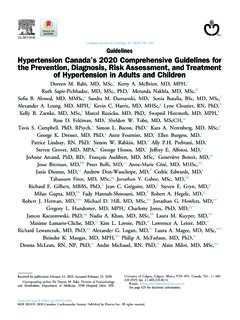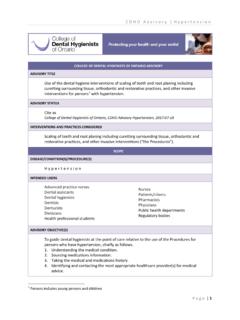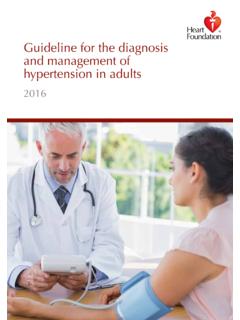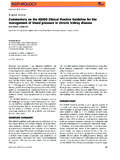Transcription of 2016 - guidelines.hypertension.ca
1 2016 hypertension Canada CHEP Guidelines for the Management of hypertension (FULL VERSION)Annual UpdateTABLE OF CONTENTS2016 hypertension Canada CHEP Guidelines for the Management of HypertensionDiagnosis & Assessment ..1 Prevention & Treatment ..13Ta b l e s ..23 Supplemental Tables .. 29 Guidelines Task Force for the 2016 hypertension Canada CHEP Guidelines ..41 DIAGNOSIS & ASSESSMENTPART 12016 Guidelines2I ACCURATE MEASUREMENT OF blood PRESSURE1) Health care professionals who have been specifically trained to measure blood pressure (BP) accurately should assess BP in all adult patients at all appropriate visits to determine cardiovascular risk and monitor antihypertensive treatment (Grade D) .2) Use of standardized measurement techniques and validated equipment for all methods (non-automated office BP, automated office BP, home BP monitoring, and ambulatory BP monitoring) is recommended (Grade D; See Supplementary Table S2 [Office BP measurement, automated office BP], Section VII [HBPM], Section VIII [ABPM], Table 1 in Section VII [HBPM], and Table 2 in Section VIII [ABPM]).
2 Measurement using electronic (oscillometric) upper arm devices is preferred over auscultation (Grade C) . (Unless specified otherwise, electronic [oscillometric] measurement should be used .)3) Four approaches can be used to assess BP: i) Office BP measurement taken with a non-automated device (non-AOBP): A systolic BP (SBP) 140 mmHg or a diastolic BP (DBP) 90 mmHg is high, and an SBP between 130-139 mmHg and/or a DBP between 85-89 mmHg is high-normal (Grade C) .ii) Automated office BP (AOBP): AOBP is the preferred method of performing in-office BP measurement (Grade D) (new recommendation) . When using AOBP (Supplemental Table S2, AOBP), a displayed mean SBP 135 mmHg or DBP 85 mmHg is high (Grade D) . iii) ABPM: Using ABPM (Recommendations in Section VIII, ABPM), patients can be diagnosed as hypertensive if the mean awake SBP is 135 mmHg or the DBP is 85 mmHg or if the mean 24-hour SBP is 130 mmHg or the DBP is 80 mmHg (Grade C).
3 Iv) HBPM: (Recommendations in Section VII, HBPM) Patients can be diagnosed as hypertensive if the mean SBP is 135 mmHg or the DBP is 85 mmHg (Grade C) . If the OBPM is high and the mean home BP is < 135/85 mmHg, it is advisable to either repeat home monitoring to confirm the home BP is <135/85 mmHg or perform 24-hour ABPM to confirm that the mean 24-hour ABPM is <130/80 mmHg and the mean awake ABPM is <135/85 mmHg before diagnosing WCH (Grade D) .3II CRITERIA FOR DIAGNOSIS OF hypertension AND RECOMMENDATIONS FOR FOLLOW-UP1) At initial presentation, patients demonstrating features of a hypertensive urgency or emergency (Supplemental Table S3) should be diagnosed as hypertensive and require immediate management (Grade D) . In all other patients, at least 2 more readings should be taken during the same visit.
4 If using OBPM, the first reading should be discarded and the latter readings averaged . If using AOBP, the BP calculated and displayed by the device should be used .2) If the visit 1 office BP measurement is high-normal (thresholds outlined in section I-3) annual follow-up is recommended (Grade C) . 3) If the visit 1 mean non-AOBP or AOBP is high (thresholds outlined in section I-3), a history and physical examination should be performed and, if clinically indicated, diagnostic tests to search for target organ damage (Supplemental Table S4) and associated cardiovascular risk factors (Supplemental Table S5) should be arranged within two visits . Exogenous factors that can induce or aggravate hypertension should be assessed and removed if possible (Supplemental Table S6) . Visit 2 should be scheduled within 1 month (Grade D).
5 4) If the visit 1 mean non-AOBP or AOBP SBP is 180 mmHg and/or DBP is 110 mmHg then hypertension is diagnosed (Grade D) .5) If the visit 1 mean non-AOBP SBP is 140-179 mmHg and/or DBP is 90-109 mmHg OR the mean AOBP SBP is 135-179 mmHg and/or DBP is 85-109 mmHg, out-of-office BP measurements should be performed before visit 2 (Grade C) . a) ABPM is the recommended out-of-office measurement method (Grade D) . Patients can be diagnosed with hypertension according to the thresholds outlined in Section I-3 .b) HBPM is recommended if ABPM is not tolerated, not readily available or due to patient preference (Grade D) . Patients can be diagnosed with hypertension according to the thresholds outlined in Section I-3 . c) If the out-of-office BP average is not elevated, WCH should be diagnosed and pharmacologic treatment should not be instituted (Grade C).
6 46) If the out-of-office measurement, although preferred, is NOT performed after visit 1, then patients can be diagnosed as hypertensive using serial office BP measurement visits if any of the following conditions are met:a) At visit 2, mean office BP measurement (averaged across all visits) is 140 mmHg systolic and/or 90 mmHg diastolic in patients with macrovascular target organ damage, diabetes mellitus, or CKD (glomerular filtration rate [GFR] <60 mL/min/1 .73m2) (Grade D); b) At visit 3, mean office BP measurement (averaged across all visits) is 160 mmHg systolic or 100 mmHg diastolic; c) At visit 5, mean office BP measurement (averaged across all visits) is 140 mmHg systolic or 90 mmHg diastolic .7) Investigations for secondary causes of hypertension should be initiated in patients with suggestive clinical and/or laboratory features (outlined in Sections V and VI) (Grade D).
7 8) If at the last diagnostic visit the patient is not diagnosed as hypertensive and has no evidence of macrovascular target organ damage, the patient s BP should be assessed at yearly intervals (Grade D) . 9) Hypertensive patients actively modifying their health behaviors should be followed up at 3- to 6-month intervals . Shorter intervals (every 1 or 2 months) are needed for patients with higher BPs (Grade D) .10) Patients on antihypertensive drug treatment should be seen monthly or every 2 months, depending on the level of BP, until readings on 2 consecutive visits are below their target (Grade D) . Shorter intervals between visits will be needed for symptomatic patients and those with severe hypertension , intolerance to antihypertensive drugs, or target organ damage (Grade D) . When the target BP has been reached, patients should be seen at 3- to 6-month intervals (Grade D).
8 III ASSESSMENT OF OVERALL CARDIOVASCULAR RISK IN HYPERTENSIVE PATIENTS1) Global cardiovascular risk should be assessed . Multifac-torial risk assessment models can be used to predict more accurately an individual s global cardiovascular risk (Grade A) and to use antihypertensive therapy more efficiently (Grade D) . In the absence of Canadian data to determine the accuracy of risk calculations, avoid using absolute levels of risk to support treatment decisions (Grade C) .52) Consider informing patients of their global risk to improve the effectiveness of risk factor modification (Grade B) . Consider also using analogies that describe comparative risk such as Cardiovascular Age , Vascular Age or Heart Age to inform patients of their risk status (Grade B) .IV ROUTINE AND OPTIONAL LABORATORY TESTS FOR THE INVESTIGATION OF PATIENTS WITH HYPERTENSION1) Routine laboratory tests that should be performed for the investigation of all patients with hypertension include:i) urinalysis (Grade D)ii) blood chemistry (potassium, sodium, and creatinine) (Grade D);iii) fasting blood glucose and/or glycated hemoglobin (A1C) (Grade D);iv) Serum total cholesterol, low-density lipoprotein, high-density lipoprotein (HDL), non-HDL cholesterol, and triglycerides (Grade D); lipids may be drawn fasting or non-fasting (Grade C) (revised recommendation).
9 V) standard 12-lead electrocardiography (Grade C) .2) Assess urinary albumin excretion in patients with diabetes (Grade D) .3) All treated hypertensive patients should be monitored according to the current Canadian Diabetes Association (CDA) guidelines for the new appearance of diabetes (Grade B)4) During the maintenance phase of hypertension management, tests (including those for electrolytes, creatinine and fasting lipids), should be repeated with a frequency reflecting the clinical situation (Grade D) .V ASSESSMENT FOR RENOVASCULAR HYPERTENSION1) Patients presenting two or more of the clinical clues listed below, suggesting renovascular hypertension , should be investigated (Grade D) .i) sudden onset or worsening of hypertension and age greater than 55 or less than 30 years;ii) the presence of an abdominal bruit;iii) hypertension resistant to three or more drugs;iv) increase in serum creatinine level of 30% associated with use of an angiotensin-converting enzyme inhibitor or angiotensin II receptor antagonist;v) other atherosclerotic vascular disease, particularly in patients who smoke or have dyslipidemia;6vi) recurrent pulmonary edema associated with hypertensive surges.
10 2) When available, the following tests are recommended to aid in the usual screening for renal vascular disease: captopril-enhanced radioisotope renal scan, Doppler sonography, magnetic resonance angiography and CT- angiography (for those with normal renal function) (Grade B) . Captopril-enhanced radioisotope renal scan is not recommended for those with CKD (GFR <60 mL/min/1 .73 m2) . (Grade D) .VI ENDOCRINE HYPERTENSIONA. Hyperaldosteronism: Screening and Diagnosis:1) Screening for hyperaldosteronism should be considered for the following patients (Grade D):i) hypertensive patients with spontaneous hypokalemia (K+ less than 3 .5 mmol/L) or marked diuretic-induced hypokalemia (K+ less than 3 .0 mmol/L);ii) patients with hypertension refractory to treatment with three or more drugs; andiii) hypertensive patients found to have an incidental adrenal adenoma.







